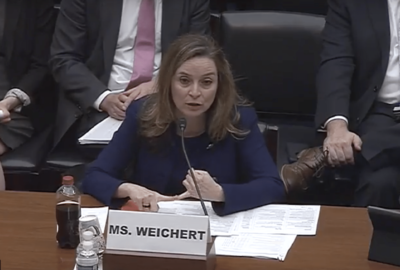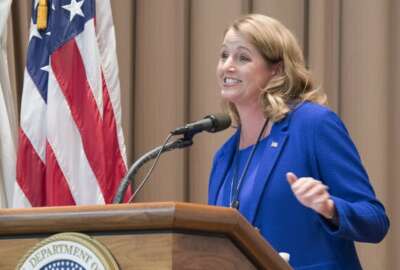
Hubbard Radio Washington DC, LLC. All rights reserved. This website is not intended for users located within the European Economic Area.
Hubbard Radio Washington DC, LLC. All rights reserved. This website is not intended for users located within the European Economic Area.
Despite the momentum gathering around the Trump administration's priority around transforming customer service in government, agencies still face challenges get...
Best listening experience is on Chrome, Firefox or Safari. Subscribe to Federal Drive’s daily audio interviews on Apple Podcasts or PodcastOne.
Despite the momentum gathering around the Trump administration’s priority of transforming customer service in government, agencies still face challenges getting feedback from the public under the Paperwork Reduction Act (PRA).
But the Veterans Affairs Administration, which leads the cross-agency priority (CAP) goal focused on customer service, is playing a key role in an interagency coalition aimed at tweaking the PRA.
Lee Becker, the chief of staff at the VA’s Veterans Experience Office, said Thursday that under the customer experience CAP goal, VA, together with the Office of Management and Budget, the General Services Administration and the Office of Information and Regulatory Affairs are looking at workarounds to some of the hurdles caused by the PRA.
“We’re very excited about that partnership, and they’ve been very open to those ideas,” Becker said at the Bipartisan Policy Center in Washington.
Lawmakers have also made their own efforts to overhaul the Paperwork Reduction Act. Last November, the Senate passed the Federal Agency Customer Experience Act, which would exempt “voluntary feedback” from agency customers under the PRA.
However, the bill has stalled for a year, and its sponsor, Sen. Claire McCaskill (D-Mo.) lost her midterm reelection bid against Republican challenger Josh Hawley.
In the meantime, the VA has wasted no time looking at ways to rethink the ways they collect data from veterans. This summer, it rolled out a “digital comment card” that allows visitors to any of the agency’s medical centers to provide direct feedback through an app.
“We can [now] collect data in a very innovative way,” Becker said. “The way PRA was addressed, it was for a time where we may not have had that opportunity, and so now we have this new way of doing business.”
Anil Tilbe, the director of Enterprise Measurement & Design in the VA’s Veterans Experience Office, said his team looks to highlight the ways veterans can submit comments.
“What we’re thinking now is turning those off, because they’re getting pushed to the veteran and instead of giving them an opportunity to come to us using a public-facing portal. Think of UberEats — you just order food and you know exactly where to go in the app, especially if you’re disgruntled,” Tilbe said. “We want to deploy a capability where you can go to a website, make a selection of the administration of where you were seen. If it’s VHA, select the clinic or the facility where you were seen and just be able to write a concern or a compliment or a recommendation. That would itself be very significant and is something we’ve been working on for a while now.”
Without quality data from veterans, the VA can’t tailor their services around veterans’ needs. Becker said this all came to a head in 2014 at the Phoenix VA.
“We were not meeting the needs of veterans. Our data was showing that we were getting veterans to appointments that they asked for, but the veterans were saying that they weren’t getting those appointments. But we didn’t have the data to really understand the veteran’s perspective. We didn’t have that data — we just had the operational data,” Becker said.
But more recently, the VA has found that better data leads to a better veteran experience. For example, this week it launched a new version of VA.gov that serves as one-stop shop veterans can use to access the services they’re looking for.
And in VA medical centers, Becker said the VA has stood up its Red Coat Ambassadors program.
“Veterans were saying they were having difficulty walking the hallways in the hospital, because it’s confusing — it looks like Frankenstein, as it was built over 30-40 years,” he said. “These are employees and volunteers that help guide the veteran around the hospital.”
Tilbe added that the Veterans Experience Office is also looking at artificial intelligence to better leverage the feedback they get from veterans.
“This needs to be captured in the overall [data] strategy, a big focus on AI, because if free text is coming in, there has to be a mechanism using natural language processing and machine intelligence — not just machine learning — to really look at that information, be able to analyze it, parse it, really get deep into deep learning, and figure out what to do with those insights,” he said.
The Office of Management and Budget won’t roll out a draft of its federal data strategy until January 2019. But until then, it’s collecting feedback from the public and giving some hints of what will go into the final document.
Erik Noble is a senior policy advisor at the White House’s Office of Science and Technology Policy. It’s co-leading with OMB to stand up the federal data strategy, along with the Small Business Administration and the Commerce Department.
“We want to develop a federal data strategy that prioritizes the usefulness of taxpayer-funded data,” he said. “We want to elicit use cases of where government data can be the most helpful, especially outside of the government.”
Two of the leading voices behind the federal strategy, Federal Chief Information Officer Suzette Kent and OMB Deputy Director for Management Margaret Weichert, also serving as acting director of the Office of Personnel Management, have already discussed opportunities to commercialize government data.
“We want to open federal data to the maximum extent possible for American prosperity, and we’re all about quantifying value as a basis for investment decisions,” Noble said, noting, in particular, the Trump administration’s interest in the value of government satellite imagery.
“Opening up earth observation data and derived products has grown the U.S. weather industry,” he added.
If some of the data strategy’s goals sound familiar, it’s because several administrations have tried to get a handle on agency data.
“We’re supportive of open data. However, we’ve been discussing open data for the last 20 years. I’m excited because the President’s Management Agenda introduced a cross-agency priority goal — or CAP goal, if you will — specific to developing a federal data strategy,” Noble said.
Last month, the White House released 10 principles that outline the data strategy’s main goals.
It also released 47 draft principles behind the data strategy. Kent previously described them as action items for agencies to execute. They include better data sharing between federal, state and local governments, and identifying high-value assets.
The White House also has 50 data fellows scattered across four teams tackling some of the work behind the data strategy. The fellows come from over 40 offices located in 18 agencies.
“These data fellows were chosen to serve on the working groups because of their experience and expertise at their home agencies,” Noble said. “Their work is vital to creating a strategy that works across the executive branch.”
Noble said breakthroughs in science and technology research depend on a steady stream of government data.
“For example, research in artificial intelligence and machine learning is fueled by immense amounts of training data. We can greatly improve the research in this area by opening access to the government’s vast troves of taxpayer-funded data in ways that do not compromise privacy or security,” he said. “However, it’s not enough for the government to support AI in the private sector. We must bring AI into the government as well, and it all starts with data.”
Copyright © 2024 Federal News Network. All rights reserved. This website is not intended for users located within the European Economic Area.
Jory Heckman is a reporter at Federal News Network covering U.S. Postal Service, IRS, big data and technology issues.
Follow @jheckmanWFED

